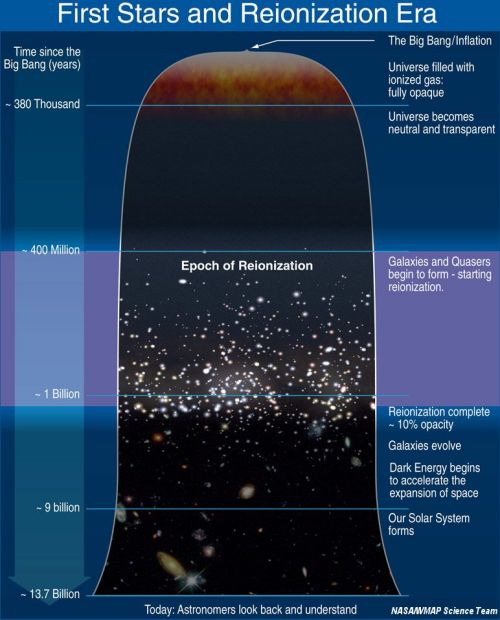Astronomy & Cosmology -
The Early Universe
(or "What Banged in the Big Bang?")
Reionization -
150 million to 1 billion Years
For a very long period, from about 380,000 years to 150 million years after the Big Bang, the Universe was transparent; but there was nothing to see!. Cosmologists refer to this period as the "Dark Ages". The inexorable march of gravity finally produced clumps of gas that started to contract to form the first stars about 150 million years after the birth of the Universe. Soon after, Galaxies and Quasars started to form as well.
While there is some debate, most cosmologists believe that many of the early Population III stars were very large and hot, emitting huge quantities of strong ultraviolet radiation, and burning up in very short timescales, perhaps less than a million years. This energy started to strip the electrons from the clouds of neutral hydrogen surrounding the stars in a process called re-ionization. Quasars may have contributed to the process, but their relatively small numbers mean that it was probably the stars that produced the bulk of the reionization. It is not just the initial energy required to ionize the atoms; a constant source of energy is required to keep the nuclei and electrons apart once they are separated. This depends upon the production rate per unit volume of photons energetic enough to ionize the atoms. The continuing expansion of the Universe had lowered the density of matter such that the reionization did not cause the Universe to become opaque again, so it has remained transparent to this day.
Helium was also reionized, but here it was probably the quasars that were responsible as helium requires about four times the energy of hydrogen to become ionized. The very powerful ultraviolet light from quasars can travel for distances of tens of megaparsecs, producing ionized helium "bubbles" far from the quasars producing them. This helium ionization affect has been observed in some closer quasars, where the clouds lie between us and the quasar, due to the absorption of certain wavelengths of the quasar's light by the cloud.
You can find a rather more technical discussion of reionization at astrobites.
While there is some debate, most cosmologists believe that many of the early Population III stars were very large and hot, emitting huge quantities of strong ultraviolet radiation, and burning up in very short timescales, perhaps less than a million years. This energy started to strip the electrons from the clouds of neutral hydrogen surrounding the stars in a process called re-ionization. Quasars may have contributed to the process, but their relatively small numbers mean that it was probably the stars that produced the bulk of the reionization. It is not just the initial energy required to ionize the atoms; a constant source of energy is required to keep the nuclei and electrons apart once they are separated. This depends upon the production rate per unit volume of photons energetic enough to ionize the atoms. The continuing expansion of the Universe had lowered the density of matter such that the reionization did not cause the Universe to become opaque again, so it has remained transparent to this day.
Helium was also reionized, but here it was probably the quasars that were responsible as helium requires about four times the energy of hydrogen to become ionized. The very powerful ultraviolet light from quasars can travel for distances of tens of megaparsecs, producing ionized helium "bubbles" far from the quasars producing them. This helium ionization affect has been observed in some closer quasars, where the clouds lie between us and the quasar, due to the absorption of certain wavelengths of the quasar's light by the cloud.
You can find a rather more technical discussion of reionization at astrobites.


